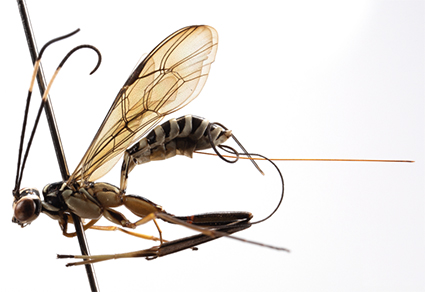Abstract
Darwin wasps (Hymenoptera: Ichneumonidae) are parasitoids and a natural enemy of a wide range of holometabolous insects and spiders and are considered one of the largest families in the animal kingdom. Unfortunately, there are great gaps in the knowledge of this family in Colombia. This study aims to expand the knowledge of Darwin wasps in Colombia, through new records for the country and especially the department of Antioquia. We present the diagnosis and digital images of the recorded species, and we describe for the first time the males of three species of Dolichomitus Smith, 1877: D. mariajosae Araujo & Pádua, 2020; D. menai Araujo & Pádua, 2020; D. orejuelai Araujo & Pádua, 2020.
References
Alvarado, M. (2018) Nocturnal Aphanistes (Hymenoptera: Ichneumonidae: Anomaloninae) in the Neotropical region, with the description of five new species. Zootaxa, 4369 (2), 221–236. https://doi.org/10.11646/zootaxa.4369.2.4
Alvarado, M. & Palacio, E. (2021) Forrestopius Gauld & Sithole, 2002 (Hymenoptera: Ichneumonidae: Metopiinae) in South America. Zootaxa, 5040 (2), 265–282. https://doi.org/10.11646/zootaxa.5040.2.6
Araujo, R.O., Alvarado, M., Fernandes, D.R.R. & Mazariegos, L.A. (2022) New records for the Neotropical Anomaloninae (Hymenoptera: Ichneumonidae) in South America. Acta Biológica Colombiana, 27 (2), 308–311. https://doi.org/10.15446/abc.v27n2.89666
Araujo, R.O., Pádua, D.G., Jaramillo, J. & Mazariegos, L.A. (2020) Five new species of Dolichomitus Smith from the tropical Andes, with a key for the South American species (Hymenoptera, Ichneumonidae, Pimplinae). ZooKeys, 937, 89–113. https://doi.org/10.3897/zookeys.937.51361
Broad, G.R., Shaw, M.R. & Fitton, M.G. (2018) Ichneumonid Wasps (Hymenoptera: Ichneumonoidea): their Classification and Biology. Handbooks for the Identification of British Insects. Vol 7. Part 12. Royal Entomological Society, London, 418 pp.
Dasch, C.E. (1964) The Neotropic Diplazontinae (Hymenoptera, Ichneumonidae). Contributions of the American Entomological Institute, 1 (1), 1–78.
Díaz, F.A. (2000) The Venezuelan Species of Pimpla (Hymenoptera: Ichneumonidae). Journal of Hymenoptera Research, 9 (2), 246–253.
Díaz, F.A. (2008) Five New Species of the Neotropical Genus Ganodes Townes (Hymenoptera: Ichneumonidae). Neotropical Entomology, 37 (6), 668–673.
Dyer, L.A., Walla, T.R., Greeney, H.F., Stireman III, J.O. & Hazen, R.F. (2010) Diversity of Interactions: A Metric for Studies of Biodiversity, Biotropica, 42 (3), 281–289. https://doi.org/10.1111/j.1744-7429.2009.00624.x
Gauld, I.D. (1991) The Ichneumonidae of Costa Rica, 1. Memoirs of the American Entomological Institute, 47, 1–589.
Gómez, I.C., Sääksjärvi, I.E., Puhakka, L., Castillo, C. & Bordera, S. (2015) The Peruvian Amazonian species of Epirhyssa Cresson (Hymenoptera: Ichneumonidae: Rhyssinae), with notes on tropical species richness. Zootaxa, 3937 (2), 311–336. https://doi.org/10.11646/zootaxa.3937.2.4
Klopfstein, S., Santos, B.F., Shaw, M.R., Alvarado, M., Bennett, A.M.R., Dal Pos, D., Giannotta, M., Herrera Florez, A.F., Karlsson, D., Khalaim, A.I., Lima, A.R., Mikó, I., Sääksjärvi, I.E., Shimizu, S., Spasojevic, T., van Noort, S., Vilhelmsen, L. & Broad, G.R. (2019) Darwin wasps: a new name heralds renewed efforts to unravel the evolutionary history of Ichneumonidae. Entomological Communications, 1, ec01006. https://doi.org/10.37486/2675-1305.ec01006
Krieger, R. (1905) Ueber die Ichneumonidengattung Neotheronia Krieger. (Hym.). Zeitschrift für Systematische Hymenopterologie und Dipterologie, 5, 286–338.
Pádua, D.G., Araujo, R.O. & Mazariegos, L.A. (2019) Pimpla Fabricius (Hymenoptera: Ichneumonidae: Pimplinae) from Colombia. Zootaxa, 4683 (3), 439–446. https://doi.org/10.11646/zootaxa.4683.3.8
Pádua, D.G., Sääksjärvi, I.E., Monteiro, R.F. & Oliveira, M.L. (2020) Review of the New World genus Acrotaphus Townes, 1960 (Hymenoptera: Ichneumonidae: Pimplinae), with descriptions of fifteen new species. Zootaxa, 4719 (1), 1–62. https://doi.org/10.11646/zootaxa.4719.1.1
Porter, C.C. (1970) A Revision of the South American Species of Coccygomimus (Hymenoptera, Ichneumonidae). Studia Entomologica, 13, 1–192.
Shorthouse, D.P. (2010) SimpleMappr, an online tool to produce publication-quality point maps. Available from: https://www.simplemappr.net (accessed 8 November 2022)
Veijalainen, A., Sääksjärvi, I.E., Erwin, T.L., Gómez, I.C. & Longino, J.T. (2013) Subfamily composition of Ichneumonidae (Hymenoptera) from western Amazonia: Insights into diversity of tropical parasitoid wasps. Insect Conservation and Diversity, 6 (1), 26–37. https://doi.org/10.1111/j.1752-4598.2012.00185.x
Yu, D.S., van Achterberg, C. & Horstmann, K. (2016) World Ichneumonoidea 2015: Taxonomy, Biology, Morphology and Distribution. Taxapad 2016. [Database on flash-drive]


